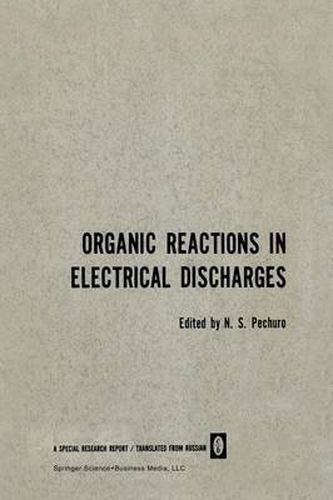Readings Newsletter
Become a Readings Member to make your shopping experience even easier.
Sign in or sign up for free!
You’re not far away from qualifying for FREE standard shipping within Australia
You’ve qualified for FREE standard shipping within Australia
The cart is loading…






This title is printed to order. This book may have been self-published. If so, we cannot guarantee the quality of the content. In the main most books will have gone through the editing process however some may not. We therefore suggest that you be aware of this before ordering this book. If in doubt check either the author or publisher’s details as we are unable to accept any returns unless they are faulty. Please contact us if you have any questions.
Recently interest has arisen in the use of electrical discharges to effect chemical reactions. Various types of discharges enable us to alter the conditions of a process over a wide range, and often ro combine the high electron temperatures necessary to activ ate certainreactions with the low molecular temperatures of the medium used. This makes it possible to simplify the techniques and apparatus required for a process, and to quench the products, thus preventing them from decomposing again. Same work on the use of electrical discharges has already found practical applications, These include the preparation of oxides of nitrogen, hydrocyanic acid, ozone, and hydrogen peroxide, thickening of oils, synthesis of acetylene and its homologs, hydrogenation and dehydrogenation of various oils and animal fats, etc, In the heavy organic-synthesis industry, lower olefins and acetylenes are used an a !arge scale as raw ma terials for producing many valuable products, Methods of producing ethylene, propylene, and butylenes from gaseous and liquid hydrocarbon feedstocks have been widely adopted. However, the production of acetylene which is an important and sometimes indispensable initial product-is mainly based an calcium carbide. De spite a number of recent improvements, this method of acetylene production suffers from high electric power consumption and expensive raw materials, requires several stages, and produces !arge amounts of waste products. V arious lines are being followed in the attempt to find new, more sophisticated means of producing acetylene.
$9.00 standard shipping within Australia
FREE standard shipping within Australia for orders over $100.00
Express & International shipping calculated at checkout
This title is printed to order. This book may have been self-published. If so, we cannot guarantee the quality of the content. In the main most books will have gone through the editing process however some may not. We therefore suggest that you be aware of this before ordering this book. If in doubt check either the author or publisher’s details as we are unable to accept any returns unless they are faulty. Please contact us if you have any questions.
Recently interest has arisen in the use of electrical discharges to effect chemical reactions. Various types of discharges enable us to alter the conditions of a process over a wide range, and often ro combine the high electron temperatures necessary to activ ate certainreactions with the low molecular temperatures of the medium used. This makes it possible to simplify the techniques and apparatus required for a process, and to quench the products, thus preventing them from decomposing again. Same work on the use of electrical discharges has already found practical applications, These include the preparation of oxides of nitrogen, hydrocyanic acid, ozone, and hydrogen peroxide, thickening of oils, synthesis of acetylene and its homologs, hydrogenation and dehydrogenation of various oils and animal fats, etc, In the heavy organic-synthesis industry, lower olefins and acetylenes are used an a !arge scale as raw ma terials for producing many valuable products, Methods of producing ethylene, propylene, and butylenes from gaseous and liquid hydrocarbon feedstocks have been widely adopted. However, the production of acetylene which is an important and sometimes indispensable initial product-is mainly based an calcium carbide. De spite a number of recent improvements, this method of acetylene production suffers from high electric power consumption and expensive raw materials, requires several stages, and produces !arge amounts of waste products. V arious lines are being followed in the attempt to find new, more sophisticated means of producing acetylene.